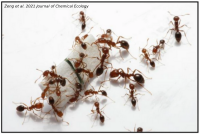
Radiation and hybridization underpin the spread of the fire ant social supergene
En présentiel : Salle Rosalind Franklin - Bâtiment IDEEV 12 route 128 - 91272 Gif-sur-Yvette
Supergenes are clusters of tightly linked genes that jointly act to produce complex phenotypes. Although widespread in nature, how such genomic elements are formed and how they spread is in most cases unclear. In the fire ant Solenopsis invicta and five closely related species, a ‘social’ supergene controls whether a colony maintains one or multiple queens. Here, we show that the three inversions constituting the social supergene emerged sequentially during the separation of the ancestral lineages of S. invicta and S. richteri. The two first inversions arose in the ancestral population of the two species, while the third one arose in S. richteri lineage. Once completely assembled, the supergene first introgressed into S. invicta, and from there into the other species of the socially polymorphic group. Surprisingly, the introgression of this large and important genomic element occurred despite recent hybridization being uncommon between some of the species. These results highlight how supergenes can readily move across species boundaries, possibly because of fitness benefits they provide and/or expression of selfish properties favoring their transmission.
En présentiel (NOUVELLE ADRESSE !) : Salle Rosalind Franklin - Bâtiment IDEEV 12 route 128 - 91272 Gif-sur-Yvette